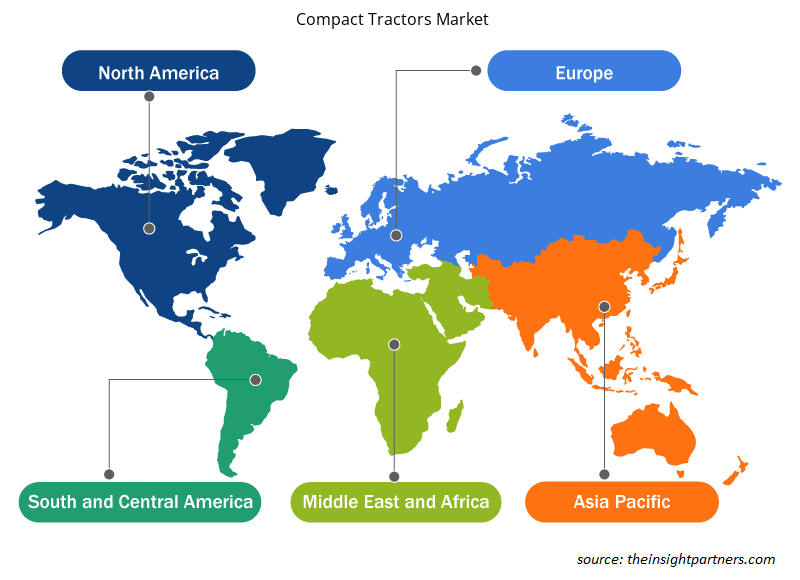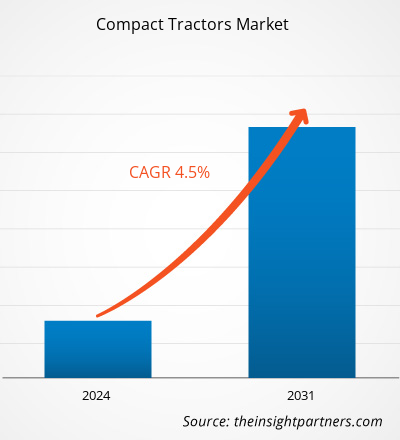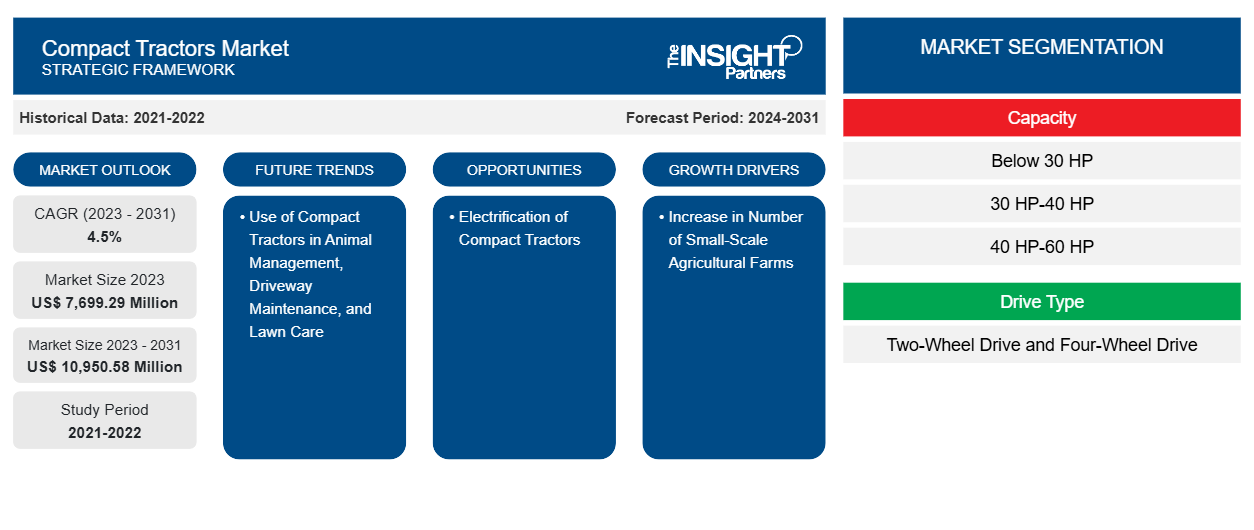紧凑型拖拉机市场规模预计将从 2023 年的 76.9929 亿美元增至 2031 年的 109.5058 亿美元。预计 2023-2031 年期间市场复合年增长率为 4.5%。紧凑型拖拉机在车道维护、草坪护理和动物或牲畜管理等不同终端用途中的应用日益增多,这可能仍是市场的主要趋势。
小型拖拉机市场分析
小型拖拉机在车道维护、草坪护理和动物或牲畜管理等不同终端用途中的应用日益增多,这为小型拖拉机市场带来了巨大的增长机会。减少人工干预和增加机器在日常工作中的应用正在推动小型拖拉机的使用。
小型拖拉机市场概况
小型拖拉机主要用于小规模农田、葡萄园、水果和坚果园。此外,小型拖拉机还可用于园艺和景观美化。此外,它们还可用于建筑行业运输货物。此外,小型拖拉机还可用于除雪和道路维护。在采矿作业中,小型拖拉机挖掘和运输碎石或砾石。
定制此报告以满足您的需求
您可以免费定制任何报告,包括本报告的部分内容、国家级分析、Excel 数据包,以及为初创企业和大学提供优惠和折扣
-
获取此报告的关键市场趋势。这个免费样品将包括数据分析,从市场趋势到估计和预测。
小型拖拉机市场驱动因素和机遇
小型农场数量增加,市场前景看好
对小规模农业的日益关注是全球紧凑型拖拉机市场的主要驱动力之一。发展中国家和发达国家小规模农场数量的增加推动了全球紧凑型拖拉机的应用。政府政策和资金等支持性举措的增加也推动了不同国家小规模农场的数量。政府对小规模农场的日益关注推动了中小型农业部门的发展,推动了全球紧凑型拖拉机的使用。
小型拖拉机的电气化
印度等主要农业国家正致力于电动小型拖拉机,通过机械化操作来缩短操作时间并提高生产率。混合动力小型拖拉机的发展是市场未来的主要趋势之一。人们对环境污染、气候变化和土壤污染的日益关注也促进了电动小型拖拉机的发展,电动小型拖拉机的碳排放量低,更环保。
小型拖拉机市场报告细分分析
有助于得出紧凑型拖拉机市场分析的关键部分是容量、驱动类型和最终用途。
- 根据容量,紧凑型拖拉机市场分为 30 HP 以下、30 HP-40 HP 和 40 HP-60 HP。40 HP - 60 HP 部分在 2023 年占据了较大的市场份额。
- 根据驱动类型,紧凑型拖拉机市场分为两轮驱动和四轮驱动。两轮驱动部分在 2023 年占据了更大的市场份额。
- 根据最终用途,紧凑型拖拉机市场分为农业和公用事业。农业部门在 2023 年占据了更大的市场份额。
紧凑型拖拉机市场份额按地区分析
紧凑型拖拉机市场报告的地理范围主要分为五个地区:北美、亚太、欧洲、中东和非洲、南美和中美。
亚太地区是市场领导者。农业部门的不断增长以及政府对农业部门的日益重视导致小型农场发展的需求不断增长,推动了亚太地区紧凑型拖拉机的增长。紧凑型拖拉机制造商的大量存在以及紧凑型拖拉机电气化的整合预计将推动北美紧凑型拖拉机市场的增长。
小型拖拉机市场区域洞察
Insight Partners 的分析师已详细解释了预测期内影响紧凑型拖拉机市场的区域趋势和因素。本节还讨论了北美、欧洲、亚太地区、中东和非洲以及南美和中美洲的紧凑型拖拉机市场细分和地理位置。

- 获取紧凑型拖拉机市场的区域特定数据
小型拖拉机市场报告范围
| 报告属性 | 细节 |
|---|---|
| 2023 年的市场规模 | 76.9929亿美元 |
| 2031 年市场规模 | 109.5058亿美元 |
| 全球复合年增长率(2023 - 2031) | 4.5% |
| 史料 | 2021-2022 |
| 预测期 | 2024-2031 |
| 涵盖的领域 |
按容量
|
| 覆盖地区和国家 |
北美
|
| 市场领导者和主要公司简介 |
|
市场参与者密度:了解其对商业动态的影响
紧凑型拖拉机市场正在快速增长,这得益于终端用户需求的不断增长,而这些需求又源于消费者偏好的不断变化、技术进步以及对产品优势的认识不断提高等因素。随着需求的增加,企业正在扩大其产品范围,进行创新以满足消费者的需求,并利用新兴趋势,从而进一步推动市场增长。
市场参与者密度是指在特定市场或行业内运营的企业或公司的分布情况。它表明在给定市场空间中,相对于其规模或总市场价值,有多少竞争对手(市场参与者)存在。
在紧凑型拖拉机市场运营的主要公司有:
- 农用拖拉机公司
- 萨姆道依茨-法尔意大利公司
- 井关工业株式会社
- LS Mitron 有限公司
- 洋马控股有限公司
- 爱科集团
免责声明:上面列出的公司没有按照任何特定顺序排列。

- 获取紧凑型拖拉机市场顶级关键参与者概览
小型拖拉机市场新闻和最新发展
小型拖拉机市场通过收集一手和二手研究后的定性和定量数据进行评估,其中包括重要的公司出版物、协会数据和数据库。以下列出了小型拖拉机市场的一些发展情况:
- LS Mitron Ltd 在展会期间为返乡农民推出了一款高端紧凑型拖拉机 MT2。MT2 具有紧凑而符合人体工程学的设计和精确的技术,可让准农民高效便捷地工作。该产品专为在果园等狭窄的地方工作而设计,具有双踏板等功能,可让操作员毫不费力地向前和向后移动车辆。(来源:LS Mitron Ltd,新闻稿,2023 年 8 月)
- Agro Tractors SpA 推出了 Fendt 200 Vario 系列,该系列设计紧凑,性能卓越。它用于葡萄园和果园。FT 200 Vario 利用 FendtONE 系统和宽敞的驾驶室实现最佳操作,并利用 Fendt Gold Star 客户服务保修提供卓越的服务和维护。Fendt 200 Vario 将通过 Fendt 经销商订购,并于 2024 年交付。(来源:Agro Tractors SpA,新闻稿,2023 年 2 月)
小型拖拉机市场报告范围和交付成果
“小型拖拉机市场规模和预测(2021-2031 年)”报告对市场进行了详细的分析,涵盖以下领域:
- 紧凑型拖拉机市场规模及全球、区域和国家层面所有主要细分市场的预测
- 紧凑型拖拉机的市场趋势以及市场动态,如驱动因素、限制因素和关键机遇
- 详细的 PEST 和 SWOT 分析
- 紧凑型拖拉机市场分析涵盖主要市场趋势、全球和区域框架、主要参与者、法规和最新市场发展
- 行业格局和竞争分析,涵盖市场集中度、热点图分析、知名参与者以及紧凑型拖拉机市场的最新发展
- 详细的公司简介
- 历史分析(2 年)、基准年、预测(7 年)及复合年增长率
- PEST和SWOT分析
- 市场规模、价值/数量 - 全球、区域、国家
- 行业和竞争格局
- Excel 数据集
近期报告
客户评价
购买理由
- 明智的决策
- 了解市场动态
- 竞争分析
- 客户洞察
- 市场预测
- 风险规避
- 战略规划
- 投资论证
- 识别新兴市场
- 优化营销策略
- 提升运营效率
- 顺应监管趋势























 获取免费样品 - 小型拖拉机市场
获取免费样品 - 小型拖拉机市场